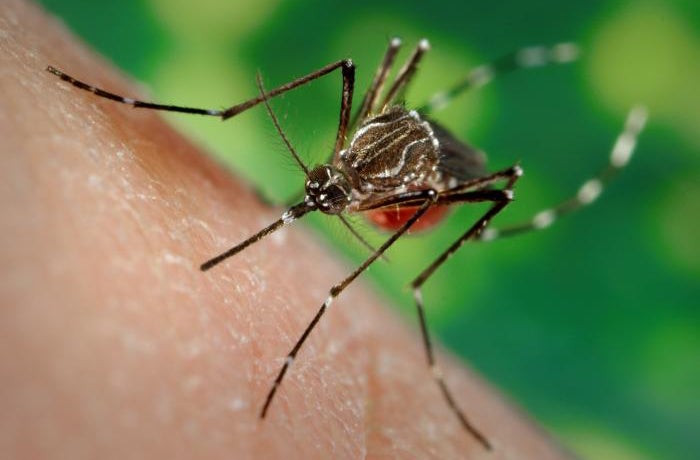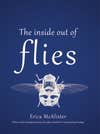Evolution made mosquitos into stealthy, sensitive vampires
With facial features to die for.

Adapted excerpt taken from The Inside Out of Flies by Erica McAlister, with permission from Firefly Books Ltd.
The mouthparts in flies are as spectacular and as diverse as their choice in food. And not just between the species, but also across the life stages. All larvae have mouthparts, though some can be very simple in structure, and are adapted for chewing or sucking at foods that range from plants to flesh. One such flesh-feeding group are in the genus Philornis, in Muscidae (the house fly family) and are found in the Americas, from Florida down to Argentina. All of the 50 or so species in the genus have larvae that are dependent on birds for their nutrition; to date they are known to parasitize over 150 birds, from hawks to hummingbirds. Different species have larvae that either feed on birds’ feces or on the blood of nestlings and occasionally of adults, sometimes attaching themselves to the outside and sometimes burrowing through the bird’s skin and feeding on blood and tissue. The adults are not so invasive in their feeding habitats and are all free-living, feeding on decaying matter. One of these species has got itself into a lot of hot water, as it is a parasite on a group of rather famous birds. Twenty years ago, Philornis downsi turned up on the Galapagos Archipelago and started feasting on Darwin’s finches.
That may be a bad story for the birds but a good example of the separation of diet between the larval and adult stage. The mouthparts of adults are very different to the larval structures as they are adapted for sucking liquid food, a very beneficial situation. The hemimetabolous species, as well as some of the holometabolous species such as the honey bees, have the same diet throughout their lives. Adult honey bees forage for nectar and pollen upon which they feed themselves and the rest of the colony, including the immature bees. Any change in the quantity and quality of this food source impacts across all generations. This is very uncommon for flies, where the adults and larvae often live in very different environments and feed on very different food.
Adult flies have strongly developed the labium into two distinct sucking forms. Mouthparts developed for suctorial feeding are called haustellate and, in flies, the mouthparts have gone one of two ways: either that of a flexible probing needle, a form referred to as stylate, as seen (and felt) with mosquitoes, or a flabby, spongy pad-like mouth termed labellate, as seen in the house flies.
The evolution of feeding tubes is known widely among the pollinators, but perhaps the most notorious “suckers” are the ones that feed on blood, the sanguivorous species. The most well-known are the mosquitoes—the females to be precise as they need the blood meal for egg development—although not all adult females are bloodsuckers. Those that are, are among the most harmful “vectors”—that is, carriers—of pathogens of humans and other animals, and so understandably have been exceptionally well studied. The first thing the female needs to do is find her bloody food source. She has to detect a “feeding station,” a process determined by chemical, visual and temperature cues. The smells are picked up by the palps, those long sensory appendages around the mouth. The smells that send these mosquitoes and other biting insects into a frenzy are carbon dioxide, and an alcohol called octenol, or mushroom alcohol (one of the many organisms that produce it naturally). We all know that we breathe out carbon dioxide but we also emit clouds of octenol in our breath and sweat—what a pleasant thought. Interestingly, it has also been found that mosquitoes seem to like the smell of wine, so maybe leave a glass at the side of your bed to lure the mosquitoes to that rather than yourself (though you would have also have to stop breathing as well, because of the CO2 issue …). Once she is nearby, she starts to pay attention to the subtler compounds that the host gives off, such as carboxylic acids (a wide range of acids), which determine exactly where she will land and ultimately strike.
Upon landing on her host, she uses her proboscis to detect the very small, thin-walled blood vessels called capillaries that crisscross our bodies just below the skin. The exact mechanism for this has only recently been determined. In 2015, Je Won Jung and a team of researchers from Seoul National University, published their findings about how mosquitoes used their proboscis to locate blood vessels and feed without being detected, because, as they wrote, “unsuccessful probing might alert the host animal to their presence, which may result in considerable risks. I would consider death one of those ‘considerable risks.’”
The team discovered sensory hairs on the proboscis, containing olfactory receptors AaOr8 and AaOr49 (terribly catchy names). These receptors are activated by chemicals found in the host’s bloodstream, enabling the female mosquito to locate the blood accurately and rapidly.

The piercing proboscis of a mosquito (and many other flies) is not a single structure, but instead comprises six separate elongated mouthparts called stylets held together when not in use. These lie alongside each other to form the fascicle, or syntrophium, encased in the thickened outside cover, the labium. The labium is the part that bunches up on the surface, as the mosquito pierces through the skin, and is what protects the delicate apparatus when not in use, as well as providing physical support when they are.
To locate a suitable place to penetrate her host, the female mosquito vibrates her stylets, a bit like starting up a drill. The region at the end of the maxillae, referred to as the laciniae, have tiny teeth on their edges and act as drill bits, tunneling through the skin and then acting as anchors to keep the stylets in place once feeding commences. Inside the fly’s head are protractor and retractor muscles, pulling and pushing at the base of the maxillae. A fused elastic structure attached to these muscles enables a rapid penetrating movement. Once in, grasping structures called mandibles hold the host’s tissues apart while the largest of the stylets, the labrum, starts probing around. It’s on the end of this stylet that receptors AsOr8 and AaOr49 are located. Once blood has been detected, the labrum pierces the vessel and sucks up the blood, much like us drinking a Bloody Mary through a straw. To keep the blood flow going, she releases saliva from the hypopharynx, which contains a tranquilizer to numb sensation. She probes and flexes her stylets under the skin to find these blood vessels, like the arms of an octopus reaching into the dark to carry out a dangerous deed.
Once all the piercing is done, the mosquito’s head also has structures to help it suck up as much blood as possible. There are two suction pumps in the female’s head, the smallest of the two at the end of her proboscis, and the larger one at the base of the throat, or oesophagus. To initiate feeding, the first pump opens to lower the pressure and draw the blood up into the proboscis. The second pump then does the same, causing the blood to be further drawn into the body.
For blood feeders to feed without their meal knowing about it is a tricky one, but it is also essential that predacious flies are not damaged by their meal. And the sanguivores and predators have developed a weapon to help them. It’s all very well catching a grasshopper twice your size—as the top predators, the robber flies, love doing—but then to have to deal with their long limbs flailing around while you’re trying to eat is tricky. Robber flies, and many other families including the horse flies, have devised a way to paralyze their prey, or parts of it, before settling down to eat from or on them. For many species of flies are venomous, and instead of administering it from a modified egg-laying tube, as do the bees, wasps and ants, they inject this venom into their prey in a way akin to the spiders.
Investigation into dipteran venoms has been very slow to progress, which seems a shame as we now know they are rather unusual. Ten new venoms have been described from robber flies, and six of these venoms include proteins that no other venomous creatures, bees, wasps, ants, snakes, conches, platypuses and so on, have. Unimaginatively, these 10 venoms have now been named Asilidin 1 to 10 (after the family name Asilidae). These venoms are purely to paralyze, none have enzymes that help digest food externally, but are instead toxic smoothies composed mostly of peptides (short chains of amino acids) and larger proteins, resulting in the pharmacological breakdown of the recipient tissues. But although this may seem terrible for the intended victim, these novel peptides are now being tested for use on humans to help in the treatment of pain, cardiovascular diseases and diabetes, to name but a few research avenues.